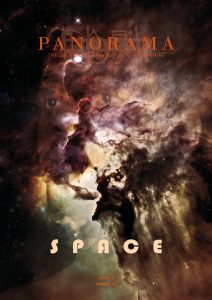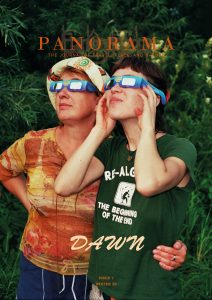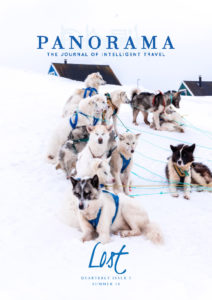I step foot on Calle Capón, one hand on my saddlebag dangling across my left shoulder. It’s half past noon, my second week in Lima. I’ve left the house late again, but finally arrived in Chinatown after perdón-ing my way off the bus. My host family in Peru applauds me for riding the crowded buses over calling a cab. Part of me does it to prove I’m a real traveller, a New Yorker who knows how to take local transportation instead of relying on taxis like those other tourists. Part of it is for the anonymity of being a passenger, traversing through the neighbourhoods of a new city, where every single street corner is a place I haven’t seen. Except on these buses, I feel like I walk into the living room of someone else’s home each time I step on. Residents stare with wider eyes or side glances. A correctly-assumed-to-be Chinese person, travelling solo, dressed in a navy-blue jacket, loose tee, and skinny jeans, trying to blend in with local currency jingling in my palms.
Lima, is the first city I am making a temporary home in on a year-long fellowship to travel to Chinatowns around the world. Recently graduated from college, I received funding to document stories of migration, displacement, and resilience across the diaspora. To the dismay of my immigrant parents, I turned down a steady city job to accept an experiential learning fellowship from my small liberal arts college. Throughout my life in New York, my parents would ask me why I go to Chinatown so often, a neighbourhood they intentionally moved out of in the journey towards upward mobility. Each of my grandparents spent decades working in garment shops and restaurants, saving each dime, and now I, with a family who owns a home, would commute an hour to regularly to go there. My grandmother would tell me Chinatown is dangerous, conjuring dim memories of the 80s, when robberies happened on streetcorners in broad daylight. I would respond, it’s not like that now to no avail. Yet, each time my family travels, they, too, seek each new city’s Chinatown to see the neighbourhood and eat our food. Really, I think it’s for grounding in a foreign place, and a sense of belonging in cities where people still stare at racial difference.
On the bus ride, I noted every chifa I passed by. Some of them are named for the regions of China the owners are presumably from: Chifa Guang Zhou; others, dropping Chinese entirely for local familiarity: Chifa Don Valencio, Dragon Dorado. Each of the restaurants, with photos of rice platters and Visa signs plastered on glass windows, made up one of the 5,000 chifas in Lima alone. Chifa, which comes from chī吃, to eat in Mandarin, and饭, fàn, rice, or a meal became the word for “Chinese restaurant” in Peruvian Spanish. The story goes that during the time of the 19th century global coolie trade, when coolie labourers in Peru were asked where they were headed at the end of the day, they would reply, 吃饭chī fàn. The term eventually became associated with the labourers eating dinner. The Chinatown in Lima began as living quarters for coolie labourers and their descendants and has changed over time to the place of commerce it is today.
After walking down the crowded main street, I feel my heartbeat speed up when I see the red beams and green imperial-style arch, the overt marker of Chinatown. Chinatown stretches multiple blocks, its main street Calle Capón, a pedestrian walkway where local Peruvians are waiting in throngs to eat at restaurants selling both roast duck and caldo de gallina. Since arriving, I’ve been amazed to hear Cantonese words in everyday Spanish. My host said sillau for soy sauce, which is 豉油, si jau, and minpao for Chinese baked goods, 面包, min baau. What is normal of everyone here becomes niche new facts for me, an American-born, whose learning of ethnic studies mainly lived within the borders of a nation.
I have my heart set on wandering Chinatown in my free time. Which is always, as an undercover anthropologist, now a world traveller, with one agenda: learn about my people and eat good food. The agenda did involve oral history interviews and a list of Chinese Peruvian associations and scholars to meet. But today was barrio chino day. I needed to know where I was in order to know where I’m headed. Intimidated by the crowd of balloon sellers, visitors taking family selfies, and resting men with their backpacks in their laps looking up at me, I turn right onto a side street. Lured in by a dangling red lantern and a large billboard menu standing out front, I enter a quiet restaurant.
A woman wearing a flamingo print apron and her hair in a bun sits in the first booth. She looks up at me from her phone. Her two kids, both of them no older than six, play with a light-up toy keyboard. They curiously gaze up at me too, then at their mother.
“Uh, para comer?” I stumble. To eat?
“Sí,” the woman says, and bursts out laughing.
“Do you speak Chinese?” she continues, this time in Cantonese.
I smile a yes. I’m in.
“It’s not often that Chinese people come into this restaurant.”
“Really? So there are not that many Chinese people that come to this Chinatown?”
She shakes her head. I learn that she immigrated three years ago, from Hoiping, the same region of southern China my father is from. Her husband had been in Peru for over twenty years and their family had several restaurants here. She tells me that when she first arrived, she went sightseeing.
“But once you live here, it’s not that exciting and the sites aren’t so special.” She laughs. Her voice is tinged with an air of something I can’t quite grasp. Her eyes are looking to the street behind us but feel farther away. She hands me a menu and looks back at me.
“Here is the fried rice and underneath are the noodles,” she says, “Oh and there are combo platters where you can get half a plate of rice and half a plate of noodles.” She gestures a split with her hands. “What would you like?”
I am squeezed in the third booth, one of five that makes her small abode. I sit on the side that looks out onto the passersby. I scan the menu of Chinese dishes written in Spanish.
“Do you have soy sauce chicken?”
A chuckle. “At this restaurant, no, but the bigger ones down the street have it.” She lists the foods those restaurants serve.
“They even have congee?” I ask, eyes gleaming.
“Yes, and there’s dim sum and roast pork you can take to-go.”
My stomach grumbles for dim sum, but I order beef fried rice, committed to meeting a new auntie from the same region as my father. The woman heads to the kitchenette next to the tables and begins to clink her spatula.
Her husband, returned from presumed errands, sits down at a wooden desk at the entrance, and quietly tinkers with screws and bolts. Her son, who I learn is three, plays with a colourful toy train that sings Yankee Doodle. Beginner Spanish vocab flashcards are strewn on the tiles. I see verduras and a photo of broccoli as the woman cooks. Her almost two-year-old daughter reaches for the same toy and the son pushes her away.
“Chinese people are all over the world,” she says, breaking my narration.
“Hai ah,” I say, “Do they live here or are they usually somewhere else?”
“We’re all over, in a lot of different neighbourhoods.” She lists San Isidro, San Borja, Miraflores, and many neighbourhoods I don’t yet know.
She hands me the soup. I take my first sip and a sense of home sweeps over me. The dish itself is plain. A clear broth with some scallions floating on top. Two wontons. Yet somehow, the chicken bone broth feels like a hug. I slurp some more. She brings over the fried rice and when I smell it, I am suddenly transported. For the first time since arriving, I am nostalgic for home. It hits me that for a year, because of the fellowship stipulations, I won’t be able to return home, to the friends, family, and familiar neighbourhoods that raised me too. Suddenly, I want to return.
“You come here, and you just miss your home country so much,” she picks up the conversation as if reading my mind. “All my friends are back home. You miss the familiar faces, the family. You’re here and you just want to keep going back.”
Listening to her speak, I begin to feel an inkling of what it must to leave a country behind in search of a better life. Something I won’t truly understand. Or in her case, unlike two hundred years ago, this time, by choice. For the economic promise that she didn’t see in the same Hoping my grandmother left with my father when he was young. Pursuit of a dream I had heard narrated over and over again. America, the land of opportunity. Peru, one too, for this woman and her family.
Born in New York, I could never fathom what it would feel like to stand upright the last suitcase and leave home for the other side of the world. I had my roots generations deep in my homeplace. Yet today, as she was sharing, I understood it a little more. I tried to imagine the Hoiping she came from. A town with neighbouring villages I hadn’t heard much about. My parents didn’t talk about Guangdong much. They arrived to New York City with their siblings decades ago. And since then, no one has returned much. Except my grandparents
As we speak, two young men with styled wavy black hair, tight-fitting t-shirts and pressed slacks stood looking at the menu photos outside.
“El menú?” she calls to them. The woman scurries out to advertise the fried rice and meat that comes with wonton soup. They order combo two and have a seat.
When one of them tries the soup, he looks at the other and shakes his head. They say something to the woman, who is back in the cooking area oiling the grill, and leaves. She carries the full bowls back, careful to not spill the soup. “They said the soup went bad.
I looked at her with my right eyebrow raised.
“It’s like that. It’s because my husband puts in pork bones to cook it. Sometimes they love it, and others think it’s rotten. There’s nothing you can do about what they say they taste.”
Throughout our conversation, she scolds her son about the mess he’s making, saying he’s causing them to lose business. We watch as people scuffle along the entrance to peer at the menu, peek inside, and continue walking. She carries her daughter, who, now asleep, is saddled on her back. She places her to rest in the firmly cushioned seat across from me, wrapped in a blanket. After a while, she is busy trying to get her husband to stop fixing furniture at the front of her restaurant.
“Can I take this rice to go?” I call.
“Was the rice too hard for you?” She packs my half-eaten plate.
It was, but I hadn’t planned to tell her that. “Just a little.”
“For me too.”
I look at her, surprised.
“That’s why I don’t like working in these restaurants. I never cook the food I would eat. None of my kids eat it either. As soon as we get off work, we go home.”
I start to wish I had chosen another place with better food for lunch, and yet, was grateful for our connection. A woman whose name I don’t know, and who doesn’t know mine, still. She continues sliding into each booth to wipe the tables and straighten the salt and pepper shakers. Soon enough, another couple walks in.
“Where did you say your other family’s restaurant was?” I ask, to continue the conversation. She describes the names of intersections I write down.
“It’s past Calle Capón. A restaurant with a single white lantern dangling out front.” She gestures the shape of the lantern.
“Maybe I’ll visit one of these days,” I tell her. She glances up from cleaning and nods.
I walk out the doorless entrance and wander until I happen upon a supermarket that says Hong Kong Market. I ponder how strange it is for me to leave home in search of my diaspora. My diaspora: people who, like this woman, I never would have known to imagine the lives of had we not shared space for a sliver in time. I had questions of home and belonging, how it’s created, how identity is shaped across cultures after generations.
My Samsung buzzes. A reminder: grupo cultural meeting, Friday. I had messaged the Asociación Peruano Chino after seeing their Facebook page. Third and fourth-generation tusanes, Chinese Peruvians, invited me to their weekly cultural group meetings. I didn’t know it then, but I would soon meet new friends who would show me what their cultural reclamation and creation of identity across generations looks like. Soon, Lima would feel like home.











